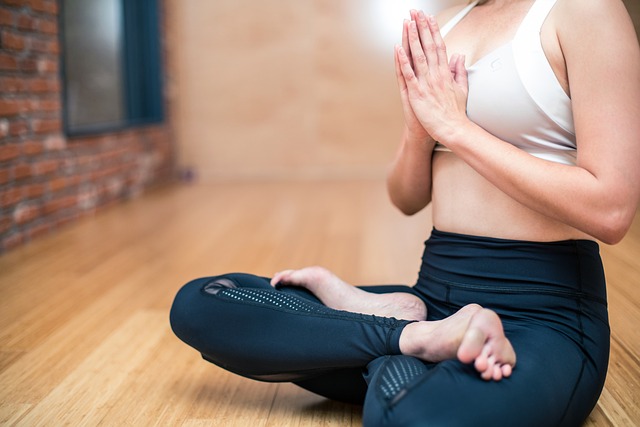
Have you ever looked at different yoga poses and wondered what they are all about? We are going to take a closer look at different yoga poses.
It’s like an adventure into a realm where you can improve your flexibility and balance. But it’s not just about physical changes.
Have you ever thought about how yoga can help you grow personally and spiritually? We’ll explore this intriguing aspect too.
Yoga is more than just exercise, it’s about feeling good in your body and mind. Whether you are beginner or expert, understanding how these poses can help you feel better is important.. These poses are like building blocks of yoga.
In our modern, sedentary lifestyles, different yoga poses offer an effective way to maintain physical health. They promote flexibility, strength and balance which are particularly important for those who spend long hours sitting at desk or using any electronic devices.
High-stress nature of contemporary life has led to an increased demand for stress reduction techniques. Yoga poses when combined with controlled breathing and mindfulness provide a powerful tool to alleviate stress and anxiety.
How many different yoga poses are there?
Yoga is a vast and ancient practice with a wide variety of yoga poses, also known as asanas. The exact number of different yoga vary depending on the source, tradition and evolving nature of this ancient practice.
Some estimates suggests that there are well over 1,000 different yoga poses.
The yoga has been around for thousands of years and has been shaped by many different cultures and traditions. Because of this people keep coming up with new poses to meet the changing needs and preferences of those who practice yoga.
These poses are sorted into different categories each meant to work on different parts of the body, mind and spirit.
It’s like having a wide menu of options to choose from, allowing people to find the poses that work best for them. Different styles of yoga, such as Hatha, Vinyasa, Ashtanga & Iyengar may emphasize different poses and sequencing, so the numbers and variety of poses can vary within these styles.
Some different yoga poses with names and benefits.
For those beginning their yoga journey, it’s common to ask, What are the benefits of yoga asanas? These physical and mental advantages may be just what you are seeking.
1. Downward Facing Dog (Adho Mukha Svanasana)
- Strengthen the arm, shoulder and back: This pose requires you to support the body weight with your arms and shoulders. Holding this position builds strength in your upper body, including arms, shoulders and upper back muscles. Over time, this can help tone and firm these areas.
- Stretches the hamstring, calves and arches: Downward facing dog involves lifting the hips and pressing the heels towards the floor. This action stretches the hamstring (back of thigh), calves and arches of the feet.
Regular practice can increase flexibility in these areas, making it beneficial for those with tight leg muscles.
- Relieves stress and energizes the body: The inversion in downward Dog, where your heart is positioned higher than your head, can have a calming effect on the nervous system. It can help reduce stress and anxiety.
- Improves postures and circulation: Regular practice of Downward facing dog encourages better posture by elongating the spine, opening chest and strengthening the muscles that supports the good posture.
It also enhance blood circulation by allowing gravity to help blood flow to the head and upper body. This position is beneficial for those who spend long hours sitting or standing.
2. Warrior I (Virabhadrasana I)
- Strengthens the legs, back and shoulders: The pose engages and strengthens the muscles in your legs, particularly the quadriceps, hamstrings and calf muscles.
Additionally promotes strength and stability in the muscles of back and shoulders.
- Opens the hips and chest: The posture involves a deep lunge with the back foot turned outward which helps open and stretch the hips, particularly the hip flexor.
At the same time, the arms extended overhead open the chest, encouraging an expansion of ribcage.
- Build focus and concentration: Warrior I demands mental concentration to maintain balance and alignment. To perform the pose correctly, you need to focus on your breathing, the positioning of your limbs and your overall body awareness. Over time, this concentration can extend beyond your yoga practice and improve your ability to concentrate in daily life.
- Develops balance and stability: It helps to connect with ground and find center of gravity which can translate into improved balance not just in yoga but in other physical activities.
3. Warrior II (Virabhadrasana II)
- Strength the legs and core: This pose promotes core strength as you stabilize your torso and pelvis.
- Enhance flexibility in the hips and groin: This pose beneficial for individuals with tight hips and groin muscles, as it encourages greater mobility and flexibility in these areas.
- Improves stamina and endurance: Warrior II is a pose that challenges both physical and mental endurance. Holding the pose for the extended period build stamina in the legs and core muscles.
As you practice regularly you will find that the capacity to hold the posture increases and your overall endurance improves.
- Encourage mental strength and endurance: staying present in the pose, concentrating on your breath and maintaining proper alignment all require mental fortitude. This can carry over into your life, helping you face challenges with greater resilience.
4. Child pose (Balasanas)
Child pose, which is common yoga pose , is often used as a resting position and is known for its gentle and comforting nature.
- Relaxes and stretches the lower back: This pose provide a stretch to the lower back, helping to release tension and ease discomfort in this area.
- It is beneficial for those with lower back pain and stiffness.
- Calms the mind and reduces the stress: The forward folding nature of child’s pose allows the chest to rest on the thighs and forehead on the ground.
- This position can induce sense of calm and relaxation, helping to quiet the mind and alleviate the stress and anxiety.
- Promotes digestion and alleviates fatigue: Child pose can create gentle pressure on the abdomen, which can stimulate digestion and helps relieve discomfort from digestive issue.
- This pose can rejuvenate the body and alleviate the feeling of tiredness and fatigue.
- Relieves tension in the shoulders and neck: The extended arm position in the child pose encourage stretching and release tension in the shoulders and neck.
- This pose is beneficial for those who spend long hour sitting at desk or having neck and shoulder stiffness
12 basic yoga poses for beginners
Mountain pose (Tadasana)
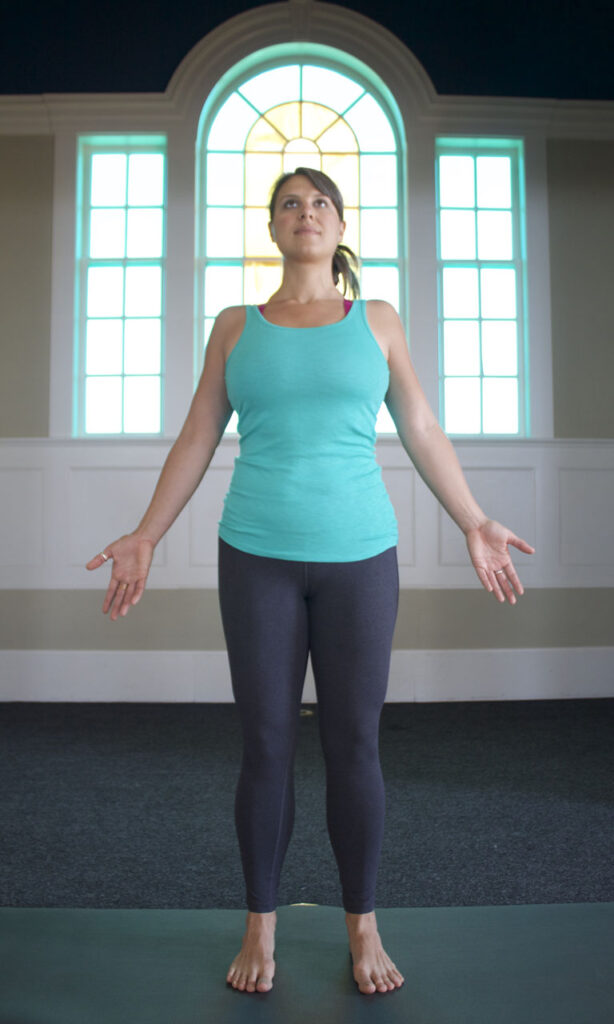
PS: pixabay.com
- Begin by standing on a flat surface with feet together. Slight gap between your heels.
- Let your arms by your side with your palms facing forward.
- Visualize yourself as a mountain.
- Make sure you are putting same amount of weight on your both foot. Engaging your leg muscles by lifting your kneecaps slightly.
- Ensure your pelvis in neutral position. Ensure your head is in natural position, with the chin level with the ground. Relax your facial muscles.
- Pay attention on your breath. Take slow, deep breaths in through your nose and exhale through your nose or mouth.
- Mountain pose encourages mindfulness. Be present in the moment, aware of your alignment, balance and rise and fall of your breath.
Child pose (Balasanas)
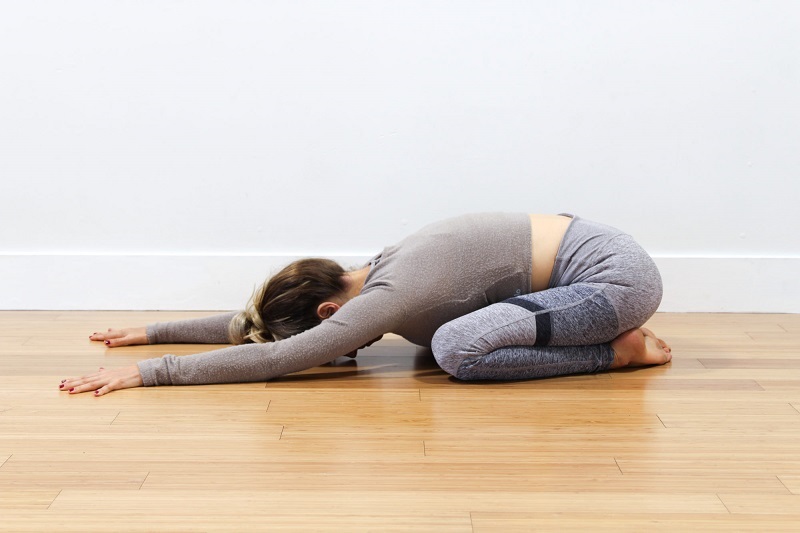
- Start with table top position (align your wrists under your shoulder and your knees under your hips.)
- Inhale and bring your big toes together. Sit back on your heels by slowly lowering your buttocks.
- Exhale as you gradually lower your upper body towards the ground. Extend your arms forward and rest your palms on the mat in front of you. Keep your arms active by pressing your palms into the mat.
- This helps in stretching your spine.
- Let the forehead gently touch the ground. If the forehead doesn’t touch the ground, use a cushion to support your head.
- Your buttocks should rest comfortably on your heels and your chest should be positioned on the thighs.
- Take deep breaths to help release tension and stress.
Triangle pose (Trikonasanas)
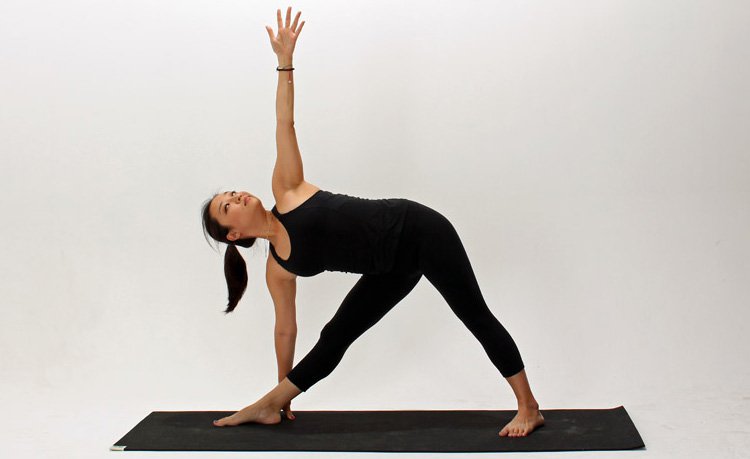
- Position your feet at a distance of 3-4 feet from each other.
- Extend your arms out to the sides parallel to the ground with your palms facing down.
- Begin to tilt your upper body to the left and reaching down to your left ankle.
- Raise your right arm up so that it is in line with your left arm, looking up at the right hand.
- Take deep breaths and hold the pose for 30 seconds to 1 minute.
- Inhale as you return to an upright position with your arms extended and then switch sides.
Downward facing dog (Adho Mukha Svanasanas)
- Begin in plank position.
- Lift your hips towards the ceiling, your body will form an inverted V shape.
- Keep your knees slightly bend if you are beginner or you have tight hamstrings. Pressing your heels towards the ground and feel stretch in the back of your legs.
- Spread your fingers apart to stay steady. Place your head between your arms, looking towards your feet or belly button.
- Take deep, steady breaths.
Corpse pose(Savasanas)
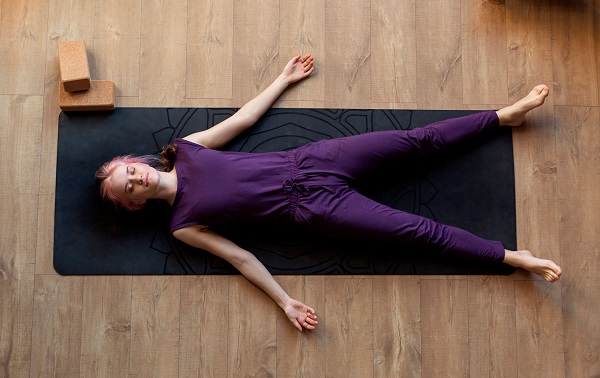
- Lie down on your back with legs extended and your arms your sides.
- Your head, neck and spine should be in a straight line.
- Let your shoulders and legs (feet) roll open naturally.
- Close your eyes. Relax your facial muscles including your jaw and tongue.
- Focus on your breath. Inhale deeply and exhale slowly.
Warrior I (Virabhadrasana I)
- Begin by stepping one foot forward into a lunge, with your back foot angled outward approx. 45 degree angle.
- Ground your front foot firmly with the knee aligned directly over the ankle.
- Raise your arms overhead, with your palms facing each other and slightly apart.
- Align your hips and shoulders so they are facing forward.
- Gaze upward, looking towards your thumbs.
Warrior II (Virabhadrasana II)
- Start by stepping one foot forward into a lunge, similar to the warrior I, but with your back foot placed parallel to the back edge of your mat.
- Extend your arms out to the sides, parallel to the ground with your palm facing downward.
- Keep your front knee aligned directly over your ankle.
- Open your hips to the side and look front hand which is extended forward.
Tree pose (Vrikshasanas)
- Stand on one leg, other leg should be lifted off the ground.
- Place the sole of lifted foot against your inner thigh or calf.
- Join your hands together in front of your chest.
- Look at a fixed point to maintain balance.
Bridge pose (setu Bandhasanas)
- Rest on your back with your knees bend. Arms should be by your sides with the palms facing down.
- Exhale and lift your hips towards the ceiling.
- Engage your glutes and keep your knees in line with your ankles.
Cat-Cow pose (Bitilasana-Marjaryasana)
- Begin with your wrists directly under your shoulders and your knees under your hips.
- Inhale, creating an arch in your back as you lift your head and tailbone towards the ceiling. (cow pose).
- Exhale, rounding your back while tucking your chin and tailbone (cat pose).
- Synchronizing your movements with your breath.
Cobra Pose (Bhujangasana)
- Rest on your belly with the legs stretched out.
- Inhale and gently lift your body with help of your hands. Ensure your lower body remain in contact with ground
- Extend your arm and arch your back, looking upward. Your elbows should be slightly bent.
Seated forward bent (Paschimottanasana)
- Sit your legs extended in front of you and heels on the ground.
- Take a deep breath and make your back straight.
- Exhale and gently lean forward at your hips trying to touch toes.
- Try to keep your back straight as much as you can.
These are different yoga poses for beginners. These poses are a good starting points of beginners. Remember to listen your body and practice with awareness.
Which yoga poses should be done daily?
A daily yoga routine can be a wonderful way to maintain and improve your mental and physical well- being.
While the specific poses you should do daily can vary depending on your individual goals and needs, here are some easy yoga poses that are generally safe and beneficial for most people to include in a daily practice.
Mountain pose (Tadasana), Triangle pose (Trikonasanas), Tree pose (Vrikshasanas), Cobra Pose (Bhujangasana), Cat-Cow pose (Bitilasana-Marjaryasana), Seated forward bent (Paschimottanasana), Warrior I (Virabhadrasana I), Warrior II (Virabhadrasana II)
Yoga poses for different body parts
Yoga is a holistic practice that can benefit the entire body, but there are specific poses that target different body parts and areas. Here are some easy yoga poses categorized by the body parts they primarily engage and benefit:
For spine
- Cat-cow pose: Improve flexibility and mobility of spine.
- Cobra pose: Strengthens and stretches spine.
- Child pose: Provide a gentle stretch for spine.
For legs
- Warrior I: Strengthens and stretches the legs especially quadriceps and flexors.
- Warrior II: Tone the legs muscles.
- Triangle pose: Stretches and strengthens the legs and hamstrings.
For the core
- Boat pose: Works on abdominal muscles and core strength
- Plank pose: Strengthen the core, shoulders and arms.
- Downward Facing Dog: Support overall body strength.
For hips and groin
- Pigeon pose: Open and stretches the hip and groin
- Butterfly pose: Improve flexibility and mobility in hip and groin
For shoulder and arms
- Downward Facing Dog: Strengthens arms, shoulders and chest
- Dolphin Pose: Providing deep stretch in shoulder and arm
For the back
- Bridge pose: Strengthens back muscles and alleviate back pain
- Child pose: Offer gentle stretch in back
Yoga poses for different chakras
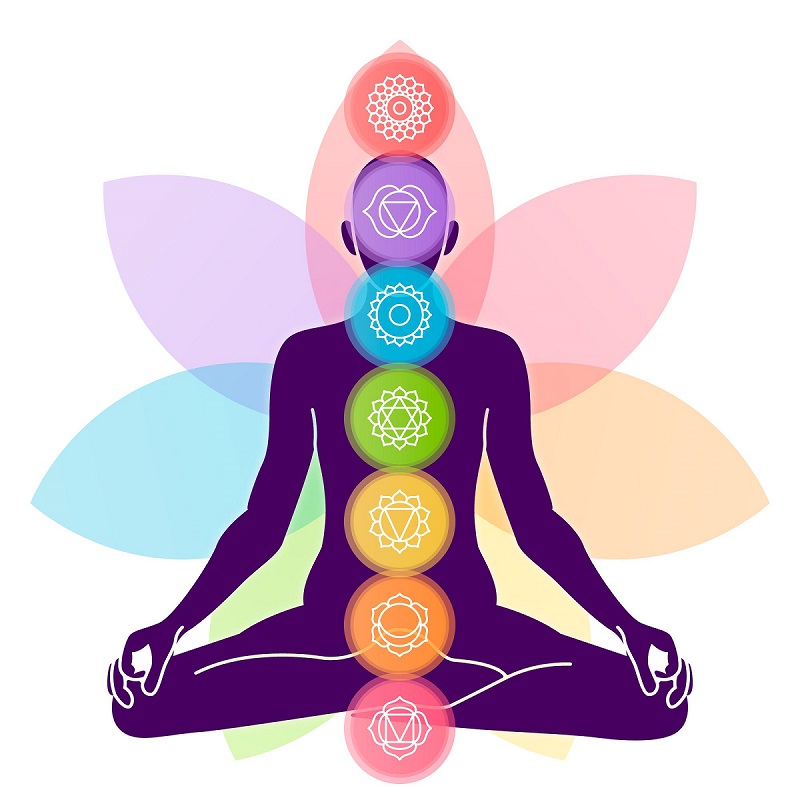
Yoga include the concept of chakras, which are energy centers located along the spine. Each Chakra is associated with physical, emotional qualities. Here are some easy yoga poses associated with each of the seven main chakras.
Root Chakra :
- Associated with grounding, stability and security.
- Poses: Mountain pose, Tree pose, Warrior I
Sacral Chakra
- Associated with creativity, sensuality and emotions
- Poses: Cobra pose, Butterfly pose, Bound angle pose
Solar plexus Chakra
- Associated with personal power and self esteem
- Poses: Boat pose, Warrior III, Plank pose
Heart Chakra
- Associated with love, compassion and forgiveness
- Poses: Camel pose, Bridge pose, Fish pose
Throat Chakra
- Associated with communication and self- expression
- Poses: Plow pose, Shoulder stand, Fish pose
Third eye Chakra
- Associated with intuition and insight
- Poses: Child pose, Dolphin pose, Downward Facing Dog pose
Crown Chakra
- Associated with spiritual connection
- Poses: Corpse pose, Headstand, Lotus pose.
What are four pillars of yoga?
The four pillars of yoga are like main building blocks of a healthy and balanced life. While a lot of folks think yoga is just about the exercise, it is also about, how you breathe, meditate to clear your mind and follow some good rules for living and treating others well.
- Asana(physical postures): Asana refers to the physical postures and poses practiced in yoga. It involves various body positions and movements to increase flexibility, strength and balance.
- Pranayama(Breath control): Pranayama is the practice of controlling the breath. It involves various breathing exercises to reduce stress, breathing techniques to enhance the flow of ‘prana’ in the body.
- Dhyana(meditation): This is about training your mind to focus and be calm. Meditation is like a mental exercise to make your thoughts more peaceful and organized.
- Yama & Nigama (Ethical and moral guidelines): Yama is like a guidebook for how we should treat the world around us. It is all about being kind and fair to everyone.
- Nigama is like personal rulebook for how we should behave and take care of ourselves. It is all about being good to yourself and being a balanced life.